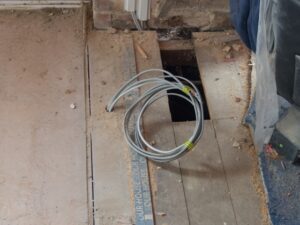When your air conditioner’s compressor clutch stops working, it can be frustrating.
You might be wondering, “Can I replace just the clutch, or do I need to replace the entire compressor?”
Good news: yes, you can replace the AC compressor clutch without needing to replace the entire compressor. This could save you both money and the hassle of getting a whole new unit.
But before diving into a replacement, it’s important to assess whether it’s worth the effort compared to investing in a new compressor.
Replacing the clutch sounds like a feasible solution, but let’s be honest—it’s NOT a simple task.
It requires the right tools and, ideally, some expertise.
Without proper knowledge, things can go wrong, leaving you with even bigger problems than before. But don’t worry, you’re not alone.
Professional help, like Excel Mechanical, is always a good choice. We’re known for our high-quality HVAC and plumbing services, ready to tackle everything from minor repairs to full replacements, all tailored to your needs and budget.
With Excel Mechanical by your side, you can rest easy knowing that your AC will be back to working order in no time.
In this blog, you will learn:
- How the AC compressor clutch works and why it’s crucial.
- The signs that indicate a faulty clutch.
- Step-by-step instructions to replace the clutch yourself, or why professional help might be a better option.
Let’s go in-depth!
Understanding the AC Compressor Clutch
Now that you know replacing the AC compressor clutch is possible, let’s dive into understanding what exactly it is and why it’s so important to the cooling performance of your car.
When your car’s AC system isn’t working right, one of the culprits could be the compressor clutch.
So, what does this component actually do, and how can it affect the functionality of your AC?
Function of the Clutch
The AC compressor clutch connects and disconnects the compressor from the engine’s power. When the air conditioning is turned on, the clutch engages the compressor to circulate refrigerant and cool the air.
This clutch operates using an electromagnetic mechanism.
A magnetic field pulls the clutch plate towards the pulley, activating the compressor. This mechanism allows your car’s AC system to manage temperature efficiently, ensuring comfort while driving.
Knowing how the clutch works can help prevent potential issues.
If the clutch does not engage, the air conditioning will not function correctly. This could be due to problems with the clutch itself or other related components.
Signs of a Faulty Clutch
Okay, so how do you know if your compressor clutch is on its last leg?
Let’s say you’ve been noticing some odd noises when you turn on your AC.
Strange squealing or grinding sounds could mean the clutch isn’t engaging like it should.
And if you’re blowing hot air, that’s a red flag too!
The clutch’s job is to get the compressor working, but if it fails, the refrigerant can’t circulate properly, and you end up with warm, uncomfortable air instead.
And don’t forget about the intermittent problems: If your AC system is turning on and off unpredictably, it could mean your clutch is wearing out.
The clutch is a part that experiences wear and tear over time, so noticing any of these issues early can save you a lot of headaches later.
Preparation for Replacement
So, you’ve noticed signs of a faulty AC compressor clutch and have decided it’s time to replace it.
But before you dive in, it’s important to make sure you’re fully prepared.
Replacing an AC compressor clutch can be a bit tricky if you’re not familiar with the process, so it’s vital to gather the right tools and follow the necessary safety precautions.
Tools and Materials Needed
What do you need to get the job done right?
Well, first, you’ll need the right set of tools. You don’t want to be running around halfway through the job looking for a wrench, right?
Here’s a list of the essentials:
- Wrench set: For loosening and tightening bolts
- Screwdrivers: To remove components and panels
- Clutch removal tool: For safely detaching the clutch from the compressor
- New compressor clutch: Obviously, you’ll need a replacement
- Pulley puller: To help remove the pulley if necessary
- Replacement belt: In case the old one is worn or damaged
Along with the tools, safety is a key factor.
Don’t forget protective gloves and eye protection. Working around car components, dirt, and grime means it’s easy for particles to fly, and you want to protect yourself from injury.
Safety Precautions
Now, let’s talk about safety.
Sure, replacing an AC compressor clutch might seem like a quick DIY fix, but there are a few things you don’t want to overlook:
- Disconnect the power: First, always disconnect the power to your car’s AC system. This simple step will protect you from electrical hazards.
- Clear your workspace: A cluttered workspace increases the chances of accidents. Keep tools within arm’s reach and ensure there are no tripping hazards.
- Know your limits: If you’re unsure about any part of the process, it’s okay to reach out to a professional. For instance, experts at Excel Mechanical have extensive experience handling AC repairs, and we can guide you through the process or even do the job for you.
By taking these precautions, you’ll ensure that your project is as safe and smooth as possible.
Remember, safety first—every time!
Assessing the Compressor Clutch
Now that you have your tools ready and safety precautions in place, it’s time to take a closer look at the AC compressor clutch.
Before diving into replacing it, you need to assess whether it really needs to be replaced or if there’s a simpler solution. Trust me, you don’t want to replace something unless it’s truly necessary.
So how do you assess the clutch?
Let’s break it down.
Inspection Steps
- Begin by turning off the AC system and ensuring your car is parked safely.
- Pop the hood and locate the AC compressor. It’s usually at the front of the engine bay. Look for any obvious signs of oil leaks around the compressor. Oil leaks can indicate a seal failure.
- Listen for noises with the engine running and the AC on. Unusual rattling or grinding sounds may suggest clutch issues.
- Check if the clutch engages when the AC is switched on—this is visible as the center part of the pulley starts spinning.
- Feel for heat. Run the AC for a few minutes, then carefully touch the clutch. If it’s excessively hot, there might be a problem with the clutch or the compressor itself.
Determining the Need for Replacement
After a solid inspection, how do you know if the clutch needs replacing?
A few things can indicate it’s time to swap it out:
- Worn-out clutch plates or damaged bearings are major indicators.
- Frequent slippage: If the clutch is slipping regularly, it’s definitely time for a replacement.
- The clutch doesn’t engage properly, leaving your car blowing hot air instead of cool.
If these issues are present, replacing the clutch might be more cost-effective than replacing the entire compressor. But remember, if the compressor itself is damaged, you may be looking at a complete replacement anyway.
Removing the Old Compressor Clutch
Alright, you’ve assessed the damage and determined it’s time to replace the AC compressor clutch. Now comes the fun part—removing the old clutch.
This step is crucial, but don’t worry, we’ll walk you through it with clear steps to ensure a smooth process.
Discharging the AC System
Before you even think about touching the clutch, you need to discharge the AC system.
Why? Well, your AC system contains refrigerant, and messing with it improperly could be dangerous, not to mention harmful to the environment.
So, let’s handle it the right way.
- Step 1: First, locate the low-pressure service port on your vehicle’s AC system. This is where you’ll connect the refrigerant recovery machine. Don’t have one? You can find one at most auto repair shops, or better yet, consult a professional.
- Step 2: Carefully extract the refrigerant. This process requires specialized equipment, so make sure you handle it safely. Don’t forget to wear protective gear like gloves and goggles to shield yourself from potential leaks. It’s essential to make sure the refrigerant is completely removed before moving forward.
Remember, refrigerant is harmful, so make sure to follow all safety measures and dispose of it properly.
Detaching the Clutch
Once the system is safely discharged, it’s time to remove the old clutch.
- Step 1: Remove the serpentine belt from the compressor pulley. This step is simple but critical. It gives you the space you need to access the clutch directly.
- Step 2: Locate the retaining bolt in the center of the clutch assembly. This bolt secures the clutch to the compressor shaft, and you’ll need the right wrench or socket to remove it. Take your time to loosen the bolt—avoid rushing through this step.
- Step 3: Once the bolt is out, gently pull the clutch assembly off the compressor. If you encounter resistance, check for any additional clips or screws that may be holding it in place. Don’t force anything; if it’s stuck, take a moment to assess the situation.
- Step 4: After removing the clutch, take a moment to inspect the surrounding components. If they appear damaged, it’s a good idea to replace those as well to avoid problems later on. This is a great time to assess the compressor and any related parts.
If you’re thinking, “this sounds a little complicated,” you’re not alone!
Removing the old clutch can be tricky if you’re not familiar with the process.
That’s where Excel Mechanical comes in.
With our experience and expertise in HVAC systems, we can make sure everything is done safely and correctly. You can rest easy knowing that all parts are handled with precision and your car’s AC system is in good hands.
Installing the New Clutch
Now that the old clutch is removed and the system is properly discharged, it’s time to install the new AC compressor clutch.
This step requires patience and precision, but don’t worry—we’ll break it down so you can handle it with confidence.
Alignment and Placement
The first thing you want to do is properly align the new clutch with the compressor. It’s not just about sticking it on—alignment is crucial for optimal performance and longevity.
- Step 1: Clean the compressor hub. Before you place the new clutch, make sure to remove any dirt, debris, or old lubricant that may have built up on the surface. A clean surface ensures better adhesion and smoother function.
- Step 2: Once the compressor hub is clean, place the new clutch on top. Alignment tools—such as a clutch alignment tool—are great for making sure everything fits perfectly. These tools help guide the clutch into place, ensuring that everything lines up just right. Trust us, alignment is key here. Even a slight misalignment can cause issues down the road, including premature wear and tear.
- Step 3: Check the alignment visually and physically. Use a straightedge to make sure the clutch and pulley are perfectly aligned. If anything looks off, you might need to adjust the position by either repositioning the compressor or using shims to achieve the right fit.
Securing Components
Once everything is aligned and properly placed, it’s time to secure the clutch to the compressor hub.
- Step 1: Using the appropriate bolts, secure the clutch in place. Make sure to tighten each bolt evenly in a crisscross pattern—this helps maintain balance and prevents uneven tightening. However, don’t over-tighten. Doing so could damage the clutch or compressor, and no one wants that headache.
- Step 2: While securing the clutch, take the time to check other components like the pulley and bearings. If you notice any worn parts, replace them now to avoid problems later on. This is your chance to prevent further issues before reassembly is complete.
- Step 3: Once the clutch is secured, reconnect the wiring. Ensure that all electrical connections are tight and secure. Loose connections can lead to malfunctions later on, so this step is critical.
Post-Installation
You’ve just replaced the AC compressor clutch—now it’s time to make sure everything is set and functioning as it should.
Getting this right is crucial to making sure your AC system runs smoothly and keeps you cool for years to come.
Recharging the AC System
The first step after installing your new AC compressor clutch is to recharge the system with refrigerant. This step is essential because it replenishes the coolant needed for your AC system to function properly.
- Step 1: Use a gauge set to check the pressure levels in the AC system. This helps you determine how much refrigerant you need to add. It’s important to get the right amount—too much or too little refrigerant can cause your system to malfunction.
- Step 2: Add the refrigerant as needed. Be sure to use the correct type of refrigerant specified for your vehicle. Overcharging or undercharging the system can cause inefficient cooling, or even worse, lead to damage over time.
If you’re unsure about this process, or if you want the job done with precision, professionals like Excel Mechanical can help. We have the experience and equipment to ensure your system is recharged perfectly.
Functional Testing
After recharging, you’ll want to test the system to make sure everything is working as expected.
Functional testing ensures that the new clutch is engaging correctly and the air conditioning is blowing cold air once more.
- Step 1: Start the car and turn on the air conditioner. Pay close attention to how the compressor clutch engages. You should hear a soft click as the clutch engages, and you’ll notice the center of the compressor pulley will start spinning.
- Step 2: Listen carefully for unusual noises. If you hear grinding, squealing, or any other abnormal sounds, that could indicate an issue with the installation or the clutch itself.
- Step 3: Check the air temperature. Turn on the AC and let it run for a few minutes. You should notice the air inside the car cooling down quickly. If the temperature stays warm or fluctuates, there might still be a problem that needs attention.
Maintenance Tips for AC Clutch Longevity
To ensure that your new AC compressor clutch lasts as long as possible, follow these simple maintenance tips. They will help you keep your AC system running efficiently and avoid costly repairs down the road.
- Keep it clean: Dust and debris can cause unnecessary wear on the clutch. Regularly clean the AC unit to remove any buildup and prevent damage.
- Inspect the belt: Check the belt tension and condition. A loose or worn belt can affect how well the clutch operates. Make sure the belt is properly tightened and in good condition.
- Lubricate moving parts: Apply the correct amount of lubricant to the moving parts of your AC system. This helps reduce friction and extends the life of the clutch.
- Schedule routine checks: Have your system checked periodically by professionals. Early detection of issues can save you time and money in the long run.
By taking these steps, you can help your new AC compressor clutch function efficiently for many years.
Why Choose Excel Mechanical?
At Excel Mechanical, we provide top-notch HVAC services tailored to your specific needs. Our team of professionals is dedicated to delivering high-quality services, ensuring that your systems run smoothly.
Whether for residential or commercial, we strive to offer the best value and quality to meet your budget and requirements.
Frequently Asked Questions
If you’re replacing your AC compressor clutch, you likely have some questions. Here are answers to some of the most common ones to help guide you through the process.
How much does it typically cost to replace an AC compressor clutch?
The cost of replacing an AC compressor clutch typically ranges from $200 to $500, but prices can vary depending on your vehicle and location. This estimate includes parts and labor.
What are the signs that an AC compressor clutch needs replacement?
Signs of a failing AC compressor clutch include strange noises when the AC is on, reduced cooling efficiency, or the AC not working at all. If you notice any of these issues, it might be time for a replacement.
How long does it typically take to replace an AC compressor clutch?
Replacing an AC compressor clutch usually takes about two to three hours. The time may vary based on the vehicle’s make and model and the technician’s experience.
Is it possible to replace just the clutch on an AC compressor, or does the entire compressor need to be replaced?
Yes, it’s possible to replace just the clutch on an AC compressor. However, if the compressor is also damaged, replacing the entire unit may be more cost-effective in the long run.
What is included in an AC compressor clutch kit?
An AC compressor clutch kit typically includes the clutch pulley, coil, and other necessary components for replacement. Make sure to get a kit that matches your vehicle’s specifications for proper fit and function.
Where can I find a service center for AC compressor clutch replacement?
For professional AC compressor clutch replacement, contact Excel Mechanical. We offer expert HVAC services and provide tailored solutions to fit your specific needs and budget. Our experienced technicians are ready to assist you with both residential and commercial systems.




